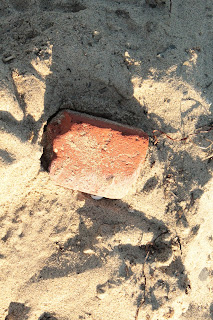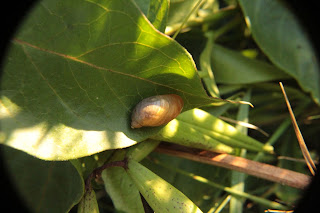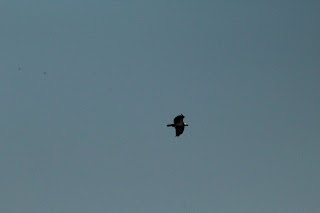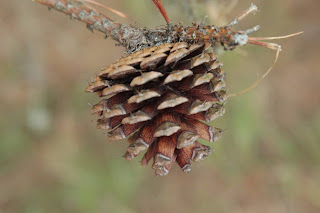What would I learn here? I went exploring along T wharf, in the south part of the island. There I found soft sand, a plethora of slipper shells, and the washed up remains of crabs.
An empty clam shell spread its angel wings open, its ghost in some crab or bird. Down the beach, I found a dead seagull. So much in the fishes' debt, it would now repay it.
How important is the estuary? Besides its role as a filter, the tide brings in plankton and nutrients, the basis of the wetland food web. There are more than 60 species of fish and shellfish in Narragansett Bay, bringing in $25 million alone. Tourism, recreational fishing, and other recreational activities bring in $400 million annually, as well as create 15,000 seasonal jobs. In addition, oysters can filter over 50 gallons a day and plankton can absorb river run off. The estuary acts as a sieve, sifting sediment back and forth. The resulting silt traps sediment and contaminants. Estuaries also help with storm protection, buffering wind and water and fighting erosion. But there is a limit to what the estuary can handle.
Threats to the estuary include loss of habitat, such as when they are filled for building or transversed by roads. Farm and fertilizer run-off, road run-off, land clearance leading to erosion, and sewage run-off can be excessive and create algal blooms, reducing dissolved oxygen in the water and killing wildlife. People with land abutting wetlands should take care not to over-fertilize their lawns and to plant native wetland species along the water's edge as a buffer zone. Non-native invasive species can quickly choke out native species, creating a monoculture that does not support the biodiversity of the species dependent on native plants and habitats.
One such native species is eelgrass. Eelgrass, one of the few seed-bearing plants that can tolerate complete submersion in brackish water, also provides habitat to fish such as shiners and North Atlantic puffer, shrimp, crabs, isopods, amphipods, bristle worms, shellfish, and the birds and other animals that eat them (including us). Our group got to seine for specimens at the T Wharf beach and were not disappointed!
 |
| Seining the beach. |
In this collection we found all of the above and a moon snail egg case!
 |
| A bristle worm, or clam worm. |
 |
| It's hard to make out in the photo, but this one was giving off bioluminescence! |
 |
| More about these Annelids here. |
 |
| Hermit crabs were everywhere! |
 |
| Two puffer fish were added to the exhibit tank. |
 |
| Shiners! |
 |
| We found two species of isopods. |
 |
| Green crab and friends. |
  |
| Whelk egg case. Whelk shell. |
 |
| Very feisty Lady crab! |
We also got to witness how fiddler crabs change the environment, softening banks with their digging and getting the marsh to "migrate"! Mussels were prevalent along the marsh creek.
 |
| Mucky and just right for some invertebrates. |
 |
| Small green crab from the creek. |
 |
| Horseshoe crab in Nag Marsh creek. |
 |
| Not a "crab", but its own Order of Arthropod. |
 |
Fossil records at the Visitor Center and exhibit. Horseshoe crabs have changed
very little over the ages and are sometimes called "living fossils". |
 |
| Dead horseshoe crab at the North End. |
 |
| Slugs hiding under the living horseshoe crab. |
 |
| Mussel bed. |
 |
| Fiddlers scatter at our approach. |
 |
| Hiding in the mud, waiting for food to go by. Only the males have the larger claw. |
 |
| Another green crab. |
 |
Clumps of peat allow grasses to grow. Cord grass actually
secretes salt to help it survive the brackish water! |
 |
| Examining peat. |
We monitored the biodiversity of the plants using a point intersection method. Basically, we lay a yard stick down, and noting at the 0, 25, 50, 75, and 100 cm marks, we wrote down the species we observed, going down in a grid pattern until we had marked 50 points. We mostly had salt meadow hay, some cord grass (which excretes salt to survive the brackish water) and spike grass, and a single marsh lavender (which is a forb). Other areas had the tasty sea pickle. At higher elevations, marsh elder shrubs took over.
  |
| Cordgrass (L), Sea pickle (R). |
 |
| Seed heads. |
 |
| Marsh elder (Iva). |
 |
| Nasty green head fly. |
With rising sea levels due to global warming, water will become more saline and elevation of water will literally drown salt marshes. Species die off. The marsh migrates to higher ground if the space and light are there. Trees die off from the saltier soil. One way monitors are trying to combat rising sea levels is to add sediment to create a blank canvas for natives to return to. It's in the experimental stages right now. Prudence Island has two mixes going down 17 cm, containing sediment with feldspar and biochar. They were put in an already drowning marsh in early spring of this year. They marsh is losing 5.5 mm of elevation a year and only building 1.3 mm a year unaided. So far, only cordgrass, which propagates itself through seeds and runners, has appeared in the sediment plugs.
 |
| Exploring Chase Way Beach. |
 |
Two sediment plugs at Sheep's Pen in the North End, where Roger
Williams and others grazed sheep once upon a time. |
Up at Coggeshall Marsh, we saw erosion first-hand. The soggy grass area was falling in and the dunes were eaten away. Without the first buffer, much of the beach will disappear. Current estimates show a
sea level rise of over 8 feet by 2100.
Another threat to the shore are invasive species. In an experiment, invasive Phragmites australis was removed along one edge of the beach and another swath left in place to compare the two. The data from both the sediment plug experiments and phragmites removal experiments are shared with others with similar habitats to help make decisions on steps to take to preserve the marshes and estuaries.
 |
| Prickly pear cactus! |
Prudence Island is unique in that some species thrive there. (I even found a prickly pear!) But the island does have a number of invasive species, including the reed Phragmites australis, Oriental bittersweet, European larch, and barberry. They also have Asian shore crabs, which range from North Carolina to Maine, perhaps even Nova Scotia. (They first appeared in New Jersey in 1988 and can reproduce several times per year.) They cross the Atlantic inside cargo ships that must take in water from their point of origin to balance their ship, then flush out that water after unloading to rebalance. We had the task of monitoring number, size, and gender of these crabs by looking under rocks and trying not to get pinched!
 |
Holding them on the side proved effective. A "Washington monument"
shape beneath indicates male. Females have a "White House" dome shape. |
 |
| Female. |
 |
| Female with eggs. |
 |
| Here, one is foaming to get oxygen. |
 |
| An interesting reddish morph. It may have recently molted. |
 |
| They hide under rocks and avoid predation by seagulls. |
 |
| This one liked me. |
 |
First, we used a 49 point grid using fishing line to note rock size:
sand, pebble, gravel, boulder. Then we removed the smaller rocks first,
grabbing all the crabs hiding underneath. |
 |
| We found many sizes, mostly male. |
 |
| 23 mm carapace. |
 |
| Using a caliper to measure. The smallest we measured were 2 mm. |
 |
| Barnacles, another kind of arthropod, covered many rocks. |
 |
| Amphipod and periwinkle snail. |
Warming waters have brought predators to the native winter flounder, lobsters are moving further north into Canada, and black sea bass are moving into Rhode Island. Maryland's blue crab may even start moving into New England states! Below, bittersweet overtakes trees and poles. Could kudzu be next?
There were signs of success, however. An area once riddled with Phragmites australis now has cattails, cordgrass, and others moving back in after intensive removal of the reed.
It is also a great area for pollinators! There were plenty of copper butterflies, who especially liked the mountain mint in the pollinator garden. I identified nine species of bees (Bombus impatiens, griseocollis, and perplexus, Apis mellifera, two Halictus, 2 Agapostemon, and a Ceratina.) I watched two slow and fat Monarch caterpillars nibble away on milkweed. Common milkweed is all over the island, but black swallowort (another invasive in the same family as milkweed, but toxic to Monarchs) has shown up too.
 |
| Copper butterfly. |
 |
| Copper on mountain mint. |
 |
| Agapostemon (Sweat bee). |
 |
| Female ruby throated hummingbird. |
 |
| Bombus perplexus. |
 |
| Ladybug larva. |
 |
| Spotless ladybug. |
 |
| Milkweed borer beetle, |
 |
| Bizarre growth?!!! |
 |
| Aphids! |
 |
| Munching Monarch caterpillar. |
 |
| Need to identify this one. |
 |
| Paper wasps. |
 |
| Cross-section of found nest. |
The Visitor Center is definitely worth a look. There are taxidermy animals from animals found deceased, a kid nook with games, books, and activities, explorer bags, t-shorts, fossil remains, nests, and two bathroom!
 |
| Snipe. |
 |
| Snowy owl. |
 |
| Harrier hawk. |
 |
Turtle skeleton. The island has nesting
diamond-back terrapins, an endangered species. |
Meanwhile, a much alive osprey hunts for fish for her young...
Next blogs: Pitch pine and controlled burning, bird watching, testing the water, and more!



















































































































No comments:
Post a Comment